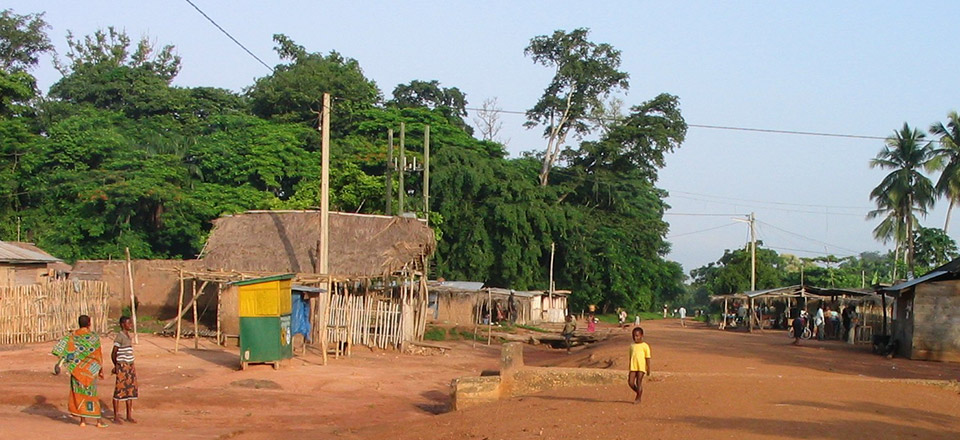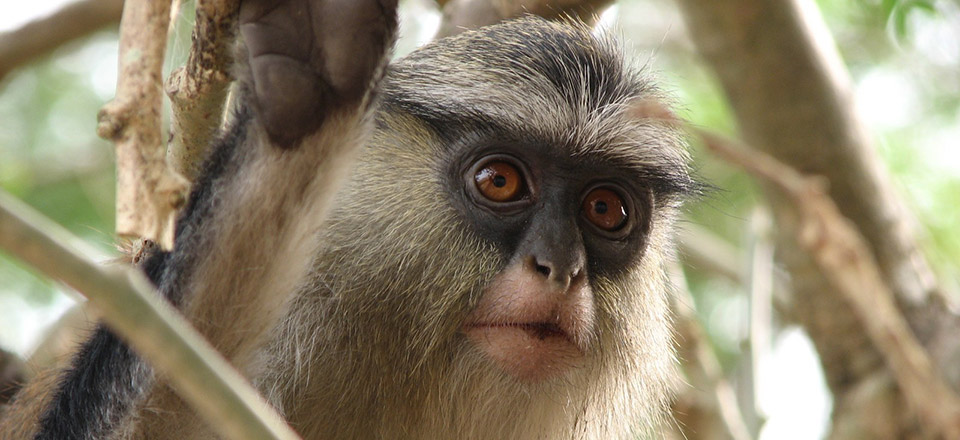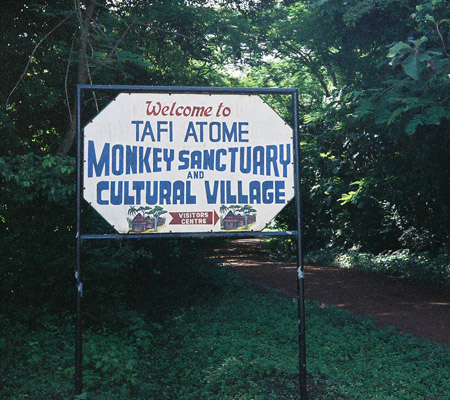Küla Tafi Atome on üle 1000 elanike ja asub Hohoe District of Volta Region Ghana. Residents speak Ewe. The village is surrounded by a sacred grove of approximately 28 on. The grove is a semi-deciduous forest and lies within the forest-savannah transitional zone. It is immediately surrounded by grassland and cultivated farmland. Salu sobitub IUCN kaitseala IV kategooria, elupaikade ja / või liikide juhtimise valdkonnas. Piirkond on kaitstud 2006 Hohoe District sundmäärus selle peamine väärtus on elupaigaks püha mona ahvid (Cercopithecus mona mona).
Vastavalt elanike, umbes 200 aastat tagasi, esivanemad elanikud Tafi Atome ala on öelnud, et on rännanud Assini Kesk Ghana Hohoe District. Nad tõid endaga iidol või kinnismõte, mis oli paigutatud püha metsa Tafi Atome, et hoida ohutu ja jahe. Mets oli kohe pühaks ja seega kaitstud. A short time after their arrival in the area, the village residents began to notice monkeys that they believed they had seen in their original region of Assini, and therefore believed that the monkeys had followed them. The monkeys were henceforth considered ‘representatives of the gods’, and protected as sacred.
1980ndatel, kohaliku Christian liider tõi vastandlikke arvamusi traditsiooniliste seadus, viinud halvenemist vaimne sidemed kinnismõte metsa ja erosiooni traditsioonilise kaitse. Residendid kärpima majanduslikult puud, eriti ümber hiis, kuni keskkonnaorganisatsioon aitas uuesti kinnitama kaitse salu 1990. Käib surve kohalikele elanikele selge metsade põllumaad ja langetada puid. There is also tourism pressure to feed the mona monkeys.
Ohustatud, there is on-going pressure from local residents to clear the forests for farmland.
Koalitsioon
The community, including the Tourism Management Committee, works with organizations including the Nature Conservation Research Centre (NCRC) to pursue tourism in order to preserve the natural and cultural heritage of the sacred grove.
Tegevus
Sisse 1995, the Accra-based Nature Conservation Research Centre visited the village of Tafi Atome and found the sacred forest in a state of degradation. Sisse 1996, a community-based ecotourism project was started in the village. Sisse 1997, mahogany trees were planted to demarcate the boundary of the sanctuary in order to halt future encroachment of farmland upon the forest edge.
1n 1998, a tourist welcome centre was built to serve as the first point of contact for tourists arriving at the village. It was funded by the community and by external donors.
The opinion of the villagers was evaluated in surveys between 2004 ja 2006.
Kaitse Tools
Mention the conservation tools or approaches that have been used or developed to support the work on the sacred natural sites. These can be tools or methods used for inventory or monitoring of plants and animals or for developing community capacity and strengthening of cultural values of the site and its people. The use of planning tools and guidelines should also be mentioned, for example the IUCN UNESCO Sacred Natural Sites Guidelines for Protected Area Managers by Wild and McLeod.
Describe the most important policies and law that support or hinder the conservation of sacred natural sites and species. Sisse 2006, the Hohoe District passed official bylaws including restrictions to enter the forest sanctuary, to damage trees, to farm within the protected area, or to kill animals in the grove.
Tulemused
Community members participating in the 2004 ja 2006 surveys said the cultural values of the community have improved as a result of tourism promotion. The arrival of tourists has also brought tourism income, which is distributed among stakeholders (e.g. fetish priest, chiefs) and used for community development, compensation for the landowners of the sanctuary, and educational funds.
- Ormsby A and Edelman, C. (2010) Kogukonnapõhiste Ökoturismi at Tafi Atome Monkey Sanctuary, a Sacred Natural Site in Ghana , in Verschuuren B., Wild R., McNeely JA. ja Oviedo G. (eds) "Looduslike pühapaikade : Conserving Nature and Culture” Earth Scan, London.
- Nature Conservation Research Centre (NCRC), Ghana: Külasta Koduleht
- Ntiamoa-Baidu, Y. (1995) Indigenous vs. Introduced biodiversity conservation strategies: the case of protected area systems in Ghana, African Biodiversity Series, 1, Biodiversity Support Program, Washington DC: Külasta Koduleht
- Ormsby, A. 2012. Perceptions of Tourism at Sacred Groves in Ghana and India. RASAALA: Recreation and Society in Africa, Asia and Latin America 3(1): 1-18.
- Ormsby, A. 2012. Cultural and Conservation Values of Sacred Forests in Ghana. p. 335-350 in Pungetti, G., G. Oviedo and D. Hooke (toim.) Sacred liikide ja kohtade: Edasiminek Biocultural Conservation. Cambridge: Cambridge University Press. Get the Publication






